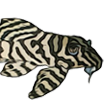Costa, WJEM, CRM Feltrin, JLO Mattos & AM Katz, 2024. Monophyly or homoplasy? The relationships of a rare new species of Cambeva (Siluriformes: Trichomycteridae) from the Brazilian Atlantic Forest with a bicolored caudal pattern. Taxonomy 4: 341-353.
Abstract
The Brazilian Atlantic Forest, one the five main biodiversity hotspots in the world, still houses many organisms that are rare and unknown to science, mostly concentrated in mountain ranges. Herein, we describe a rare new species of Cambeva from the Rio Tietê drainage at the Serra da Mantiqueira, exhibiting a caudal fin color pattern comprising a light-yellowish–white bar posteriorly edged by a black pigmented area. A similar color pattern was described for C. castroi, C. diabola, and C. melanoptera, also endemic to the Rio Paraná basin, and considered evidence of close relationships among these three species. However, other morphological characteristics highly suggest that the new species is not closely related to C. castroi, C. diabola, and C. melanoptera). Herein, we perform a molecular phylogenetic analysis using two mitochondrial genes and one nuclear gene, including all species with that bicolored caudal pattern. The analysis strongly supports the new species as a member of the alpha-clade, and therefore as distantly related to those three species belonging to the beta-clade, indicating that this color pattern has homoplastically arisen in Cambeva. The data reported here reinforce the urgent need for field studies to better understand the different evolutionary patterns found in the genus, since an intense process of environmental degradation is in course.
New Cambeva
- Silurus
- Posts: 12419
- Joined: 31 Dec 2002, 11:35
- I've donated: $12.00!
- My articles: 55
- My images: 893
- My catfish: 1
- My cats species list: 90 (i:1, k:0)
- Spotted: 424
- Location 1: Singapore
- Location 2: Moderator Emeritus





